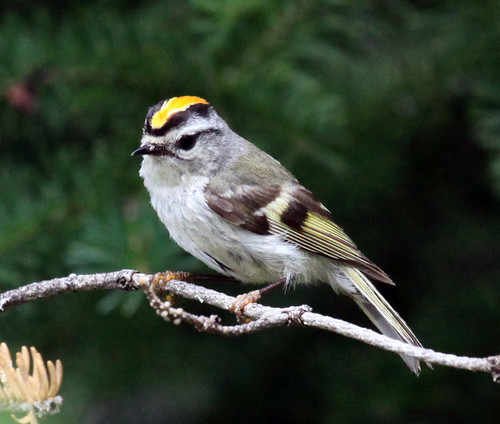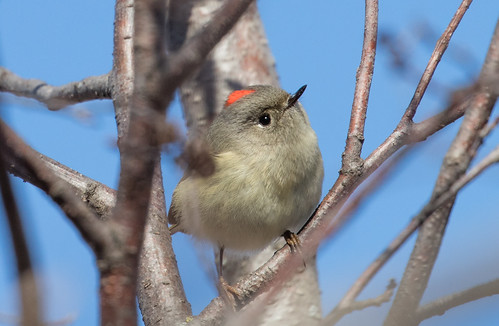In my time as a bird rehabilitator, I held a lot of different wild birds in my hands, from hummingbirds and warblers to Snowy Owls and a Great Blue Heron, but only because the birds had no choice. In my backyard, I’ve enticed perfectly healthy and free chickadees and Red-breasted Nuthatches to alight on my hand, but only by bribing them with mealworms. But there are three species of birds that have alighted on my hand without any coercion or bribes at all. I heard my lifer Pine Grosbeak before I saw him—a lone young male was whistling plaintively as I was walking toward my favorite birding spot in Madison, Wisconsin.
I whistled back to him, and this poor lonely flocking bird without a flock came closer and closer to me. When our eyes met, he seemed as delighted to find me as I was to find him. I have no idea what got into my head, but I took off my glove and raised my hand, and he alighted right on my finger! This was one of the most magical moments of my life. He whistled to me two or three more times as I whistled back and we gazed into each other’s eyes, but he seemed to realize that a mere human couldn’t provide either the companionship or the practical value of an actual Pine Grosbeak flock, and after an eternity of moments, he flitted to a nearby branch. We both kept up the whistling as he slowly, seemingly regretfully, retreated back into the woods.
Two other perfectly wild birds have also alighted on my finger, both in that same Madison, Wisconsin park. In neither case was it anywhere near as thrilling as with the Pine Grosbeak—they didn’t make eye contact, and in both cases I suspect they simply mistook my bare hand as a weird branch as they worked their way through a tangle of shrubs on frigid April mornings. The birds were ever so much tinier than the robin-sized grosbeak—indeed, they belonged to two of the tiniest songbird species in the world—the kinglets. Yes, both a Ruby-crowned Kinglet and a Golden-crowned Kinglet have alighted on my finger, both for just a couple of seconds at most, and even during that brief time looked every which way, so focused on searching for their breakfasts that I doubt if they even realized I was there.
These microscopic birds are passing through right now—they both reach the northland weeks before warblers do. Indeed, Golden-crowned Kinglets occasionally even winter up here, though unless one discovers a bird feeder, they can be very hard to notice with their exceedingly high-frequency triplet calls. Their golden crown gives some Old World relatives the name “firecrest,” conjuring not just the vivid, flaming color of the crown but a sense of fiery heat, appropriate because somehow these tiniest of all songbirds, weighing about the same as a nickel, maintain an average daytime body temperature of about 110 degrees.
Golden-crowned Kinglets are birds of the coniferous forest, with a very short tail, deeply grooved pads on their feet and a long hind toe that help them grip the tiniest conifer twigs, and just a single stiff feather covering their tiny nostrils.
The much more generalist Ruby-crowned Kinglet, which is genetically different enough that some taxonomists place it in its own genus (Corthylio instead of Regulus), has a longer tail and shorter back toe. Both male and female Golden-crowned Kinglets have a flaming yellow crown—in males, the center is a brilliant scarlet orange. Female Ruby-crowned Kinglets lack any crown color, and males keep their ruby-crown concealed unless agitated.
I can’t hear Golden-crowned Kinglet calls at all anymore, and can just barely hear their song unless I have my hearing aids cranked to eleven. But thank goodness my hearing loss doesn’t extend to Ruby-crowned Kinglet songs. I’ve been hearing them a lot this week in my own backyard, reminding me how even in a pandemic when I’m hunkering down at home, life can be sweet and soul-enriching.




